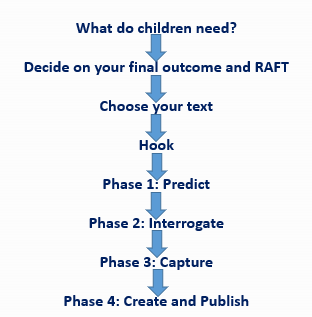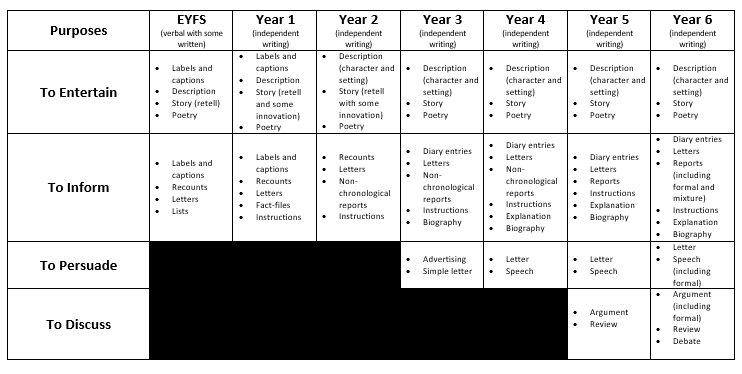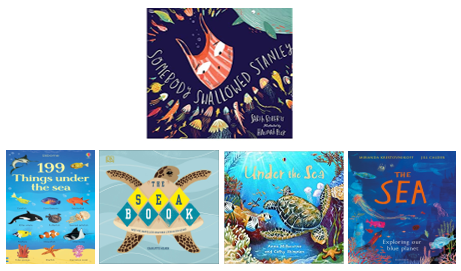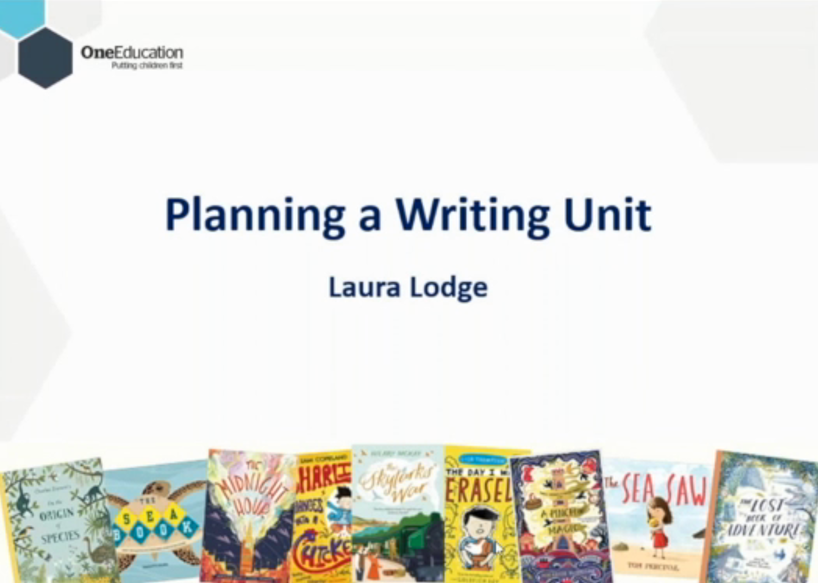Many schools have seen the power of using high-quality texts to inspire their English teaching. Text-based literacy is an amazing tool which supports schools to focus on an integrated approach to the teaching of English, however it does need to be carefully managed to result in best outcomes.
Too often, writing in school can be reduced to ‘ticking boxes’. But children need reasons to write, they need to write for reality. Think about what you have written recently. Whether it is a complaint letter; notes about something you’re working on; or even a shopping list; what unites your writing is the fact that it has purpose. Why then, do we sometimes expect children to write to please us, or just because it is something they have to learn?
“When pupils enjoy what they are writing about, they write more and they write better. When pupils have a clear sense of a real world audience that lies beyond the classroom, their writing is focused and they approach the task with a heightened sense of purpose.”
Everybody Writes Project Final Report, 2011.
Our P.I.C.C. a Text approach to planning focuses on using a quality text, such as Somebody Swallowed Stanley, to inspire real writing: writing that gives children purpose and the ability to make choices about how they write. It is a holistic approach, which prioritises the interplay between reading, writing and spoken language, giving children the tools they need to become competent real-life writers.
The P.I.C.C. a Text approach follows a clear sequence but also offers flexibility in how much time is spent on each phase, allowing schools to adapt the process according to their pupils’ needs. It can be used in all year groups from EYFS upwards, as our free unit plans show.

Deciding on Your Outcome and Aims
We often find that schools choose the texts they wish to focus upon first. Although this is tempting, especially if you have recently found a new unexpected text that you cannot put down, sometimes it can result in less successful writing. The P.I.C.C. a Text approach focuses first on thinking about outcomes and aims for the unit. This may initially be done during discussions about long term plans, however, it is important that staff knowledge of children’s needs is first taken into account. What do children need support with? With outcomes, whilst a range is important, schools often try to do too much, when deeper knowledge of fewer types of writing would be more sustainable. Our advice is to ask, what do children need to be able to write as a life skill? Do they need to know how to write a newspaper report, or is a letter more useful? Could you give them choice over their outcome perhaps? The image below shows the types of writing we would recommend are taught across school. However, this is not to say that all of those types of writing should be taught – each school needs to choose what works for their children.

Once your overall outcome has been chosen, it is important to think through exactly what your outcome should like. This does not mean writing a model text, but simply thinking each aspect through. We use R.A.F.T. to provide a structure for this:
- Reason: why are they writing?
- Audience: who are they writing for?
- Features: what are the main features I want them to focus on? What shouldn’t be included?
- Tone: how do we want our writing to sound?
By thinking through your R.A.F.T. your teaching sequence will be clearer and ensure each building block of your teaching works together to support the final goal. It also ensures that writing for reality, for a real audience and purpose, is at the forefront of planning. We will be publishing a blog exploring R.A.F.T. in more detail later this half term.
Choosing the Right Text
Once the aims have been identified, time needs to be taken to find the right text for the job at hand. Your text should support your teaching focus, however it can be a different genre. We would recommend that one main text is used, with additional companion texts selected to support building background knowledge; understanding of the theme and to provide further ideas for Writing. For instance, for the EYFS unit based on Somebody Swallowed Stanley, the main text is supplemented by companion texts including The Sea Book by Charlotte Milner. These will provide background knowledge and factual content for children’s writing about endangered sea creatures during the unit. Whichever texts you use, staff knowledge is key.

Hooking Children In
Building a love of the writing process is so important. Although having a quality text and real purpose are the most important vehicles with which to engender engagement, it is always worthwhile to think of a hook to get children thinking. A hook does not need to be spectacular – it does not need to be a crashed rocket in the playground or a dragon’s egg under a tree. A hook is anything which will get your pupils thinking – it could be an object, an image, a trip or a game, or simply a conversation.
Predict
Every P.I.C.C. a Text unit begins with a prediction session, which we would advise lasts a maximum of one lesson. The Predict phase is a chance for children to use their inference skills to begin to make links between their existing knowledge and the content of the text. Prediction can be as simple as looking at the front cover of a text, or exploring the blurb; it can involve objects or images, film or roleplay. What is important is that children make links and connections.
Encouraging progression in prediction across a single session is key – making multiple predictions, adapting them as more information is provided. This is best approached by starting from either a narrow or wide viewpoint. For instance, if predicting Somebody Swallowed Stanley, a wide viewpoint would be an image of the seabed. Children could make a prediction using only that information, being encouraged to link their ideas to prior reading. Over the course of the lesson, more information could be provided in stages (for example, different sea creatures, plastic materials, then film of plastic in the ocean), with the children adapting their prediction accordingly at each point. Likewise, a similar stepped prediction could be made from a narrow viewpoint to start, such as a jellyfish on the front cover of Somebody Swallowed Stanley, building to the front cover over time. Whichever prediction activity you choose to complete, it is important to encourage children to give justification for their predictions, either in a verbal or written form. Talk throughout is key. By giving children time to discuss and justify their ideas, their prediction skills will improve immeasurably.
The Predict phase ends with sharing the text together as a class, giving children time to develop a personal response to the text and discuss whether their predictions were correct.
Interrogate
The Interrogate phase of our approach focuses on building understanding of the inspiration text, making links between it and the text children are going to write. This phase will typically last four lessons, however, the length of the phase is dependent on need. Interrogate is comprised of three parts: Reading, Genre and GPS.
The first focus for the Interrogate phase is Reading. Reading as a reader and familiarising themselves with the text is the main thrust of this part of the unit. If children need to develop their background knowledge to truly understand the text, now is the perfect time to do this. The lessons taught within this phase will depend on the R.A.F.T. and outcome for your overall unit. Whichever you choose, the reading children engage with should directly support the unit as a whole. For instance, if children are going to be writing a letter to an author which includes their personal response to the story, spending more time reading and discussing their response to the text may be important. If a child is going to be writing in role for a diary entry, perhaps working on inference about characters’ thoughts and feelings would have the most impact.
The second focus is the explicit teaching and exploration of the genre or text type children will eventually be writing. This is important as children need to discuss models of writing, pulling them apart and discussing their effectiveness, in order to become effective writers themselves. This is where you can introduce the R.A.F.T. to children, comparing different examples of writing and discussing different writers’ approaches. In many schools, the teaching of genre has become about simply annotating texts or listing success criteria, however if you broaden your discussions into effectiveness, perhaps even ranking examples, children will gain deeper understanding.
The final focus of the Interrogate phase is the teaching of specific GPS skills in context using the inspiration texts. Of all the sessions, it is these that are most heavily affected by pupil need. You may choose to focus on word, sentence or text level objectives – whichever knowledge is needed to produce effective writing for your outcome and add to children’s understanding of English.
Once Interrogate is completed, children should have a greater understanding of the text and the technical skills required to be able to start to gather their own ideas for writing.
Capture
When we visit schools to discuss the writing process, we often discover that schools are moving straight from looking at model texts to planning and writing. This approach excises a crucial part of the writing process, one which all authors and real-life writers take time over: gathering ideas and content.
The Capture phase is designed to give children time to build knowledge; talk through their ideas collaboratively and use texts to borrow words and phrases. It gives them the chance to build their content, so that when they write, they can focus on writing effectively rather than what is coming next. We would recommend that this phase of the writing process takes approximately three lessons, but again, this is dependent on need and outcome.
The lessons within the Capture phase depend heavily on the overall outcome and aims for the unit as a whole. For instance, our KS2 unit for Somebody Swallowed Stanley builds towards children writing a persuasive speech on the problem of marine plastic pollution. The outcome means that children need understanding of the marine plastic pollution problem and devices used for persuasion. As a result, the Capture phase of this unit provides children with the opportunity to research what single use plastic is and the effect it has on the marine environment, as well as using a range of persuasive texts on different issues to gather ideas for persuasive language. A unit focused on storytelling would have a very different looking Capture phase, perhaps focusing on setting, character and plot. Whatever the focus, the importance of giving time for children to capture their ideas is key.
If anything, children need to gather too many ideas and too much content, to enable them to selectively choose what to take forward later in writing.
Create
The final phase of the P.I.C.C. a Text approach is the culmination of all the learning that has occurred over the unit. The Create phase incorporates planning, writing, editing and publishing, with our recommending that the phase lasts a minimum of three lessons but is often longer. As with all phases, teacher modelling is key, however at this point in the unit, we must ensure that modelling is focused on a different outcome to that being written by the children, to ensure independence of output.
The first step in this phase is planning to write. As children have time to gather their initial ideas during the Capture phase, this is often a case of children selecting and sequencing their content, adding key vocabulary or concepts as required to act as an aide memoire. As with any writing sequence, planning can differ greatly in appearance and approach. Whichever style of planning you prefer to engage in, modelling and shared planning is key.
Depending on children’s needs, the next step would be to engage in modelled, shared and guided writing, explicitly supporting children to use planning to form writing. This could continue throughout the Create phase, with small guided groups benefitting from specific support, as well as misconceptions and key concepts being addressed through whole class feedback.
Once children are confident in what they are writing, they need the time and space to be able to write, focusing on making effective choices linked back to the R.A.F.T. of the unit. You may wish to spend a single session on children’s independent writing, or longer. Whatever the time provided, the emphasis should always be on quality over quantity – whilst stamina is important, it is the effectiveness of the piece that should be paramount.
Once children’s first drafts have been completed, it is the time for feedback and editing to shine. Often teachers ask children to ‘check’, ‘proofread’ or ‘edit’ their work, without giving them the understanding to do this methodically. In my view, it is far better for a child to edit one or two key concepts well than ten poorly. Using whole class feedback, editing should be a sequenced process, moving from reteaching to modelled and shared editing, then on to independence. Equally important is that editing is not reduced to merely adding more content – it should be about improving the overall effectiveness of the writing related to the R.A.F.T. Effectiveness may be improved by fixing errors, or adding some missing content, but it can also be improved by removing unnecessary words, substituting content and asking if there is a more effective way to structure a sentence or idea. We will be publishing a blog post exploring best practice in editing next half term.
The final part of this phase, and indeed the whole unit, is for the work to be published. Where a piece of writing goes and how it is published will depend heavily on the R.A.F.T. Some schools demand every piece of writing to be redrafted, however it is my opinion that redrafting is important, but only if the R.A.F.T. requires it. I would much rather celebrate the whole writing process, seeing imperfect edited pieces on display, rather than only perfectly presented redrafts that hide so much of the work involved. Whether redrafted or not, it is crucial that the R.A.F.T. is acted upon. If your pupils have written to the Queen, their letters should go to Her Majesty The Queen. With publishing, children’s writing gains greater purpose; they see the power in writing as a part of life, as a reality, not just as something they have to do at school.
Our free unit plans for Somebody Swallowed Stanley exemplify the approach and can be downloaded here. If you use our planning to run the Somebody Swallowed Stanley units in your school, please share your outcomes with us via social media or by emailing us. We would love to see what your pupils come up with!
The recording of our free webinar ‘Planning a Writing Unit’ can be found on our Media Gallery. This explores the approach in detail and is linked to the free planned units for Somebody Swallowed Stanley by Sarah Roberts and Hannah Peck.
A full list of our upcoming free webinars and paid courses can be found on the @OEedDevelopment twitter account. We would love you to join us!
This blog and our free webinar are just the introduction to our P.I.C.C. a Text approach and available resources. For more information on how we can support you to develop your text-based approach to the teaching of English, please email laura.lodge@oneeducation.co.uk
















